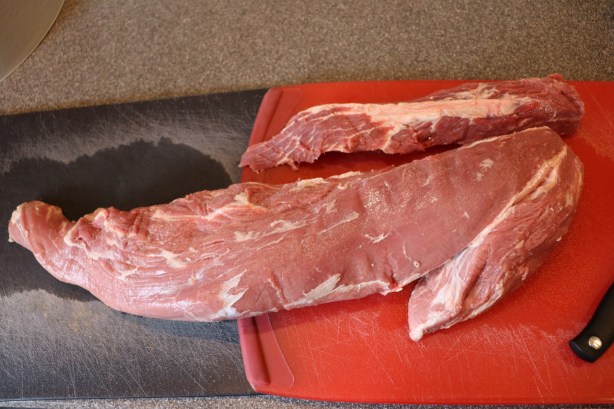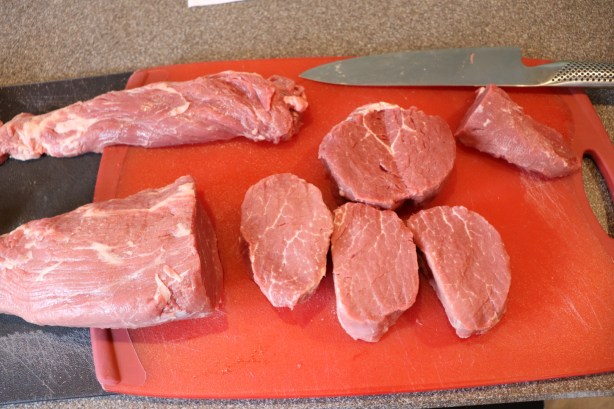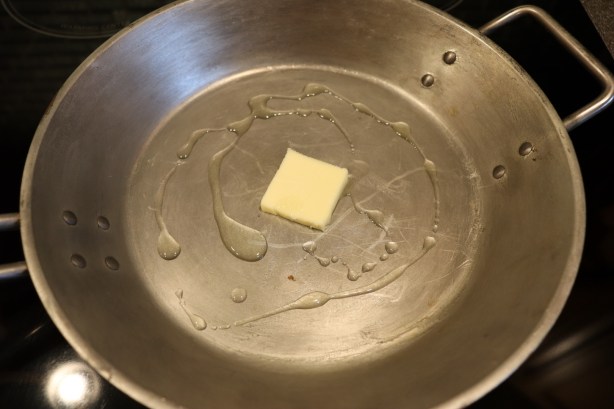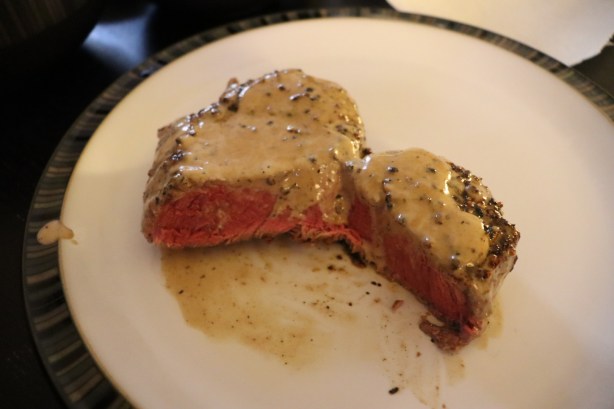I’ve mentioned previously that my dear dad was a big Good Eats fan also, but he primarily watched for education. He would adopt a lot of Alton’s kitchen hacks along the way, and occasionally an episode would grab his attention enough that he would actually run to the store and try his hand at a recipe or two. Well, the 141st episode is one that got Dad really excited because it involves purchasing a whole beef tenderloin and butchering it at home into several cuts; as a surgeon, Dad was obviously proficient at such things, and he also really enjoyed learning new skills for himself. It’s also cheaper to do the butchering at home.
There is only one recipe in this episode, but prior to doing any cooking, Alton took to his demonstrations of butchering a tenderloin. When purchasing a whole tenderloin from a store such as Costco, you will want to look for a loin that has been peeled of extra fat and has the side muscle on. Apparently, this is called a PSMO (pronounced “pismo”) in the butchery world. It took a couple weeks for us to be able to find a whole tenderloin at Costco, as there was a bit of a meat shortage for a while, and when we did find one it was more expensive than normal.
When ready to begin cutting, rinse the whole tenderloin under water and let it drain in the sink for a few minutes.

Whole beef tenderloin.
Place the loin on a long cutting board (I had to overlap two boards) with the vertebral/rough side down and the wide end away from you. If there is a large white membrane visible on the top of the meat, tear/peel/cut the membrane away to expose the tenderloin underneath. My tenderloin did not have much of this membrane.
Next, you will notice that the meat is composed of three distinct portions – the long tenderloin in the center and two additional muscles that are attached. The long thin muscle on the side of the tenderloin will come off next; it is easiest to do this by cutting from the thin end to the wide end. Once removed, set this “chain” muscle aside. This meat will be used to make Philly cheesesteak sandwiches in the next tenderloin episode.

Whole beef tenderloin. You can see the chain muscle running along the top and the small head muscle at the bottom of the wide end of the loin.

Here, the chain has been removed – to be used later for cheesesteak sandwiches. The head muscle will be cut off next – you can see it starting to separate now.
Flip the tenderloin over and remove any excess fat, shaving it off with a sharp knife running toward you. Your loin will have some silver skin on it, which is the tough, shimmery band of connective tissue that is inedible. If you have a boning knife, insert its tip under the band of silver skin, perpendicular to the loin, and lift the silver skin up. Place your finger under the silver skin and pull it tight as you slide the knife away from you to remove the silver skin. Discard all of the silver skin.
Since you have now removed the “chain” muscle from the loin, you will notice that you now have the main tenderloin and a small muscle that attaches to the wide end of the loin. Remove this small “head” muscle, setting it aside. This muscle will be used to make a stuffed tenderloin roast in the next tenderloin episode.
To portion the remaining meat, you will want to use a long slicing knife. Alton prefers to use a Granton knife, which has a long dimpled blade. I don’t have a Granton knife, so I used my sharpest chef’s knife. Without sawing through the meat, slice off the tip portion of the narrow end of the loin. Set this piece aside to make beef carpaccio later. Still working from the narrow end of the loin, use a ruler to cut a three-inch portion; this will be a butterflied filet because it is cut from a skinnier part of the tenderloin. To butterfly this piece, cut it almost all the way through at its center and fold it open to bring the sides together – you should now have a filet that is about 1.5 inches thick. The cut sides will now form the flat top of the filet.

Butterflied filet at the top and other filet below.
Next, cut three more filets, each 1.5 inches thick. We’ll get to cooking the filets soon here.

Butchered tenderloin. Top left is chain muscle for cheesesteak sandwiches. Below that is a portion that will be used for a stuffed roast. Then there are the four filets (the top one is the butterflied one), and the small piece of meat in the upper right corner is for carpaccio.
You should be left with a remaining center hunk of tenderloin that is about 1-1.5 pounds. This piece will also be used later in the next tenderloin episode to make a center cut tenderloin roast.
At this point, if you plan to use the meat soon, you can double wrap it in plastic and store it in your refrigerator. For longer storage, vacuum seal the meat and stick it in the freezer.
Steak au Poivre
After portioning that entire tenderloin, this episode only provides a recipe for the four filet portions of the loin. The remaining cuts of meat will be used in the second tenderloin episode, which, oddly, is not the next episode. Instead, there is a cocktail episode that separates the two tenderloin episodes. It seems really silly to me that the two tenderloin episodes didn’t air back-to-back since the second episode is a continuation of the first. So, yeah, I froze most of the meat I cut from my tenderloin. The filets, though, I did not freeze, but rather used to make Alton’s steak au poivre. I only cooked two filets, though, instead of four. For four filets, you want to first grind 2 T of black pepper; you want this pepper to be very coarsely ground. If your pepper mill doesn’t do a very coarse grind, place the whole peppercorns in a pie tin, top them with a towel, and crush them with a mallet. Season your four room temperature filets with Kosher salt on both sides.

Filets (the right filet is the larger butterflied one) seasoned with Kosher salt.
Then, press the filets into the ground pepper on both the top and bottom sides.
Place a 10″ skillet (NOT non-stick) over medium-high heat, adding 1 T butter and 1 t olive oil (not extra virgin).

Butter and olive oil in pan.
When the fat just starts to color and you see a tiny bit of smoke, add the steaks to the pan, cooking them for four minutes per side for medium rare. I did not do the best job with butterflying my one filet, so it ended up being considerably larger than my other three filets. Since Ted likes his steak a little less cooked than I do, I figured I would cook the larger one for Ted simultaneously with a smaller filet for me, and they would be done around the same time.
Transfer the steaks to a warm plate on a heating pad and cover them with foil.
Pour any remaining fat out of the pan (my pan had none), leaving the solids. Set the pan over high heat.

Pan after removing steaks.
Turn the burner OFF and add 1/3 C of Cognac to the pan. Use a lighter to carefully ignite the alcohol.

Cognac added to pan and ignited.
When the flames have dissipated, place the pan back over medium heat and scrape the solids off the bottom of the pan with a whisk. Add 1 C heavy cream, bringing it to a boil over medium-high heat. Cook the sauce over low heat until it has thickened to your desired consistency. Taste the sauce and adjust for seasoning with Kosher salt and pepper. Stir in 1/2 to 1 t additional Cognac.
Add the warm steaks back to the pan and turn them to coat with the sauce.
Serve the steaks immediately.

Alton’s steak au poivre.
I don’t cook steaks often, and I always really worry about overcooking them, especially when they are good cuts of meat. I cooked my steaks for four minutes on each side and they ended up being a bit underdone, unfortunately. I chose to use a pan of my parents’ that I really am not familiar with, so maybe I should have gone with my cast iron instead? I think an extra minute of cooking on each side would probably have worked very well in the pan I used. The pepper crust on the meat was fantastic and the meat almost melted in your mouth. The sauce was rich without being heavy, and the Cognac gave the sauce a little sweetness to contrast with the heat of the black pepper. This really was quite delicious. If only I had cooked my steaks just a tiny bit longer…











